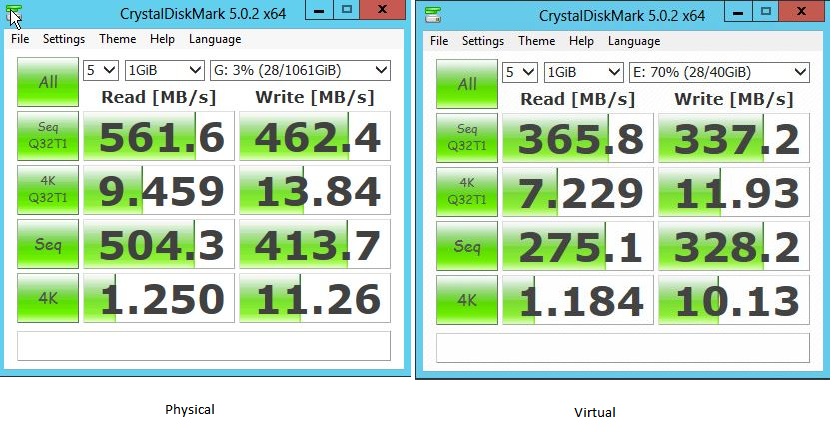Hi,
Hoping someone might be able to help me. I've googled and tried lots of troubleshooting but can't seem to come up with a solid answer.
I am repurposing an old server for use as a second ESXi host. The host has the following specs:
2x Intel 2.2GHz
48GB RAM
8x 7200rpm Enterprise SATA HDD in RAID 10
The storage controller is a LSI 9260-8i. I've flashed it to the latest firmware 12.15.0.205.
I wanted to do some stress testing of the storage system before installing ESXi so I installed Windows 2012 onto the array and ran a battery of SQLIO tests. I also ran Crystal Disk benchmark.
I measured the following maximums from my tests:
| SQLIO Pattern | Throughput |
|---|
| Sequential read | 654 MB/s |
| Sequential write | 394 MB/s |
| Random Read | 129 MB/s |
| Random Write | 83 MB/s |
I then installed ESXi 5.5U3 to a USB flash drive and formatted the RAID 10 array as a datastore. I installed Windows 2012 as a guest VM, gave it 48 Gb of RAM and 8 CPUs to mimic the physical hosts specs. I installed the latest LSI driver (6.605) for ESXi. I then reran the same tests that I did on the physical machine. The results were disappointing:
| SQLIO Pattern | Throughput |
|---|
| Sequential read | 414 MB/s |
| Sequential write | 256 MB/s |
| Random read | 103 MB/s |
| Random write | 73 MB/s |
As you can see, there is quite a difference particularly for the sequential operations. I'm trying to figure out why this would be before I put the host into production. I would not expect a 33% drop due to virtualization.
I've reran the tests several times both physical and virtual, have tried both thin and eager thick disks, reinstalling ESXi, using the built in LSI driver (5.34) and nothing makes a difference. The results are always very similar with physical being much better than virtual.
Here is a snapshot of the Crystal benchmark. Physical on the left, virtual on the right:

Anyone have any ideas?